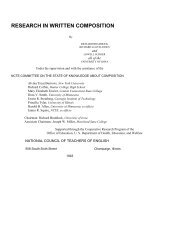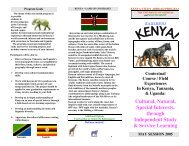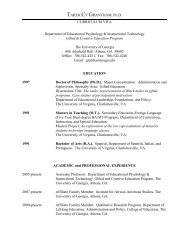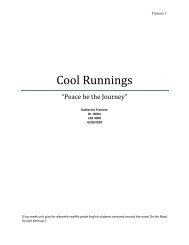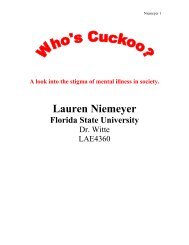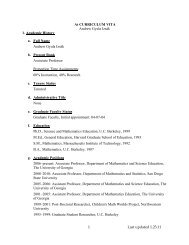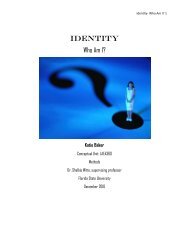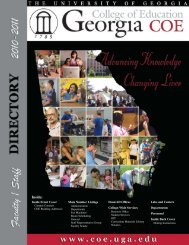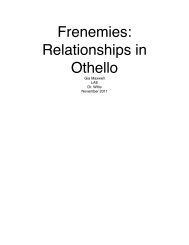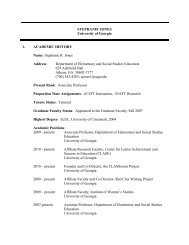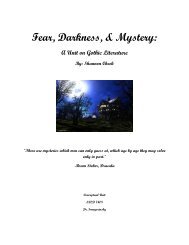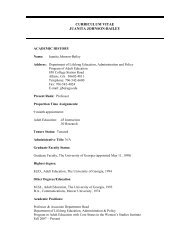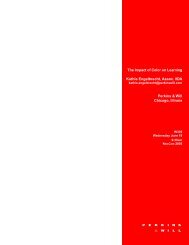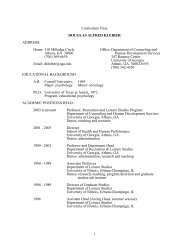Elie Wiesel's Night: Out of the Darkness - College of Education
Elie Wiesel's Night: Out of the Darkness - College of Education
Elie Wiesel's Night: Out of the Darkness - College of Education
Create successful ePaper yourself
Turn your PDF publications into a flip-book with our unique Google optimized e-Paper software.
Spring 2011<br />
Day Nine<br />
Turn in personal narratives (15 minutes)<br />
MAP testing (as long as needed)<br />
Read <strong>Night</strong> chapter 4 (remainder <strong>of</strong> class)<br />
Lesson Reflection: Today’s class was used for standardized MAP testing by <strong>the</strong> school. We<br />
took a break from <strong>Night</strong> and our regular lessons and projects in order to complete this testing.<br />
Because <strong>of</strong> <strong>the</strong> testing, <strong>the</strong>re were no standards or elements <strong>of</strong> flow designed for today’s class.<br />
Day Ten<br />
Reader Response Entry (15 minutes)<br />
Go over nonfiction presentation rubric (10-15 minutes)<br />
Fill in character log (15-20 minutes)<br />
<strong>Night</strong> chapter 4-5 (30-40 minutes)<br />
Documentary (remainder <strong>of</strong> class)<br />
Lesson Reflection: This lesson was a perfect example <strong>of</strong> breaking up <strong>the</strong> class period into<br />
blocks <strong>of</strong> different activities to keep <strong>the</strong> students interested and on task. The students were given<br />
time to work on <strong>the</strong> reader response portfolios at <strong>the</strong> beginning <strong>of</strong> class, during which I provided<br />
<strong>the</strong> students with feedback on previous entries and things that <strong>the</strong>y could improve upon for <strong>the</strong><br />
future entries. Afterward, I spent a good deal <strong>of</strong> time going over <strong>the</strong> rubric for <strong>the</strong> nonfiction<br />
presentations that will be given in <strong>the</strong> next class meeting. This allowed <strong>the</strong> students to be placed<br />
completely in control <strong>of</strong> <strong>the</strong>ir own learning through <strong>the</strong> use <strong>of</strong> <strong>the</strong> PEG. I was able to relay <strong>the</strong><br />
importance <strong>of</strong> <strong>the</strong> information about <strong>the</strong> presentations to <strong>the</strong> students, giving <strong>the</strong>m an idea <strong>of</strong> <strong>the</strong><br />
importance <strong>of</strong> <strong>the</strong> immediate information <strong>the</strong>y were getting. The students were also put in control<br />
and showed <strong>the</strong>ir competence with <strong>the</strong> material when we filled in <strong>the</strong> character log as a class.<br />
The students were allowed to briefly work with <strong>the</strong>ir neighbor to discuss what had happened in<br />
<strong>the</strong> last class as we read <strong>Night</strong>. This allowed for some brief peer interaction while also allowing<br />
<strong>the</strong> students to refresh <strong>the</strong>ir memories <strong>of</strong> <strong>the</strong> material before beginning <strong>the</strong> days reading. Because<br />
<strong>of</strong> <strong>the</strong>se elements, <strong>the</strong> students got into a flow with this lesson and did a wonderful job <strong>of</strong> taking<br />
in <strong>the</strong> information and applying it to ongoing activities and projects in <strong>the</strong> class.<br />
34 Spring 2011



